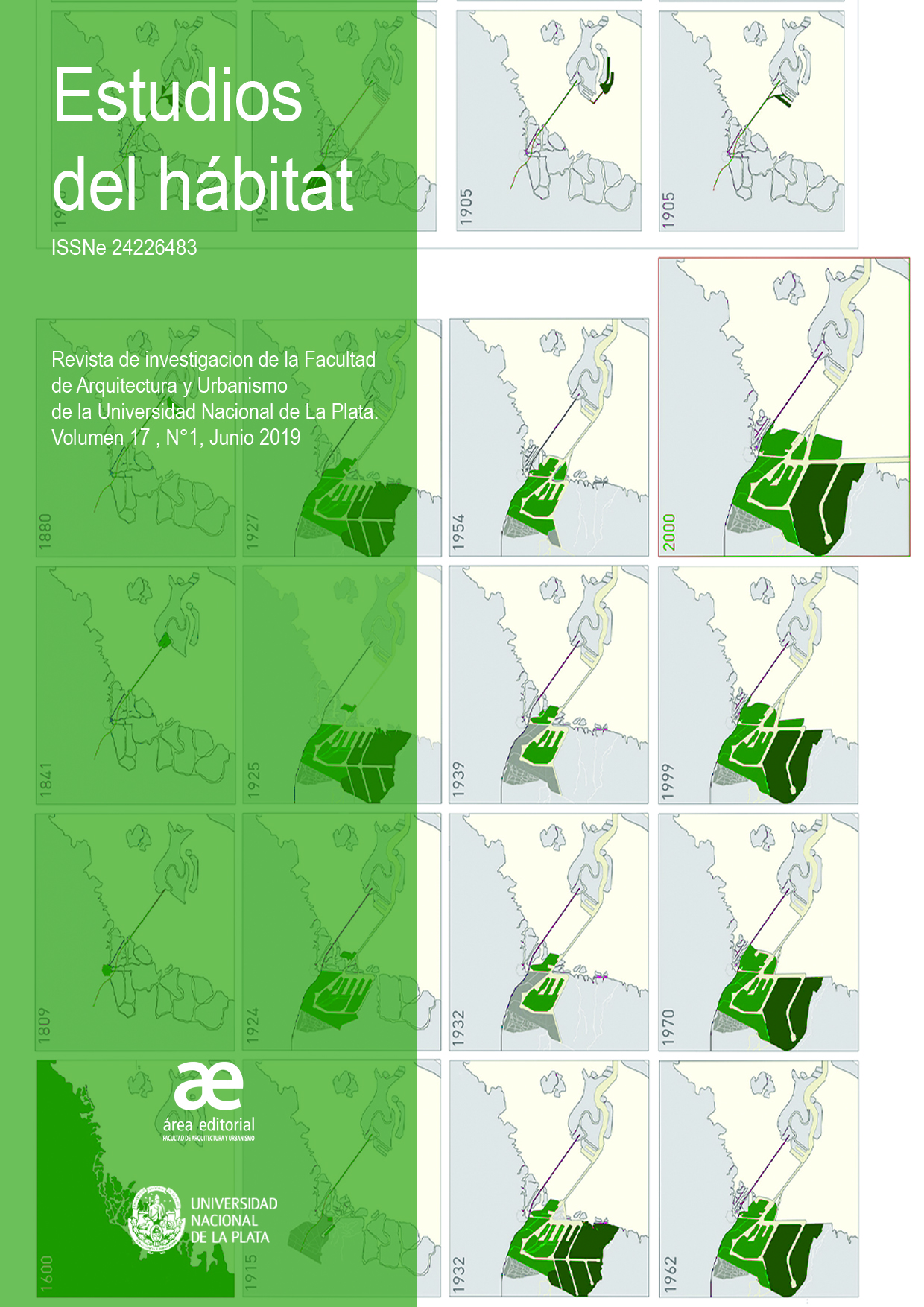From risk to resilience. Towards the design and adaptive management of the landscape
DOI:
https://doi.org/10.24215/24226483e057Keywords:
Climate change, Risk, Resilience, LandscapeAbstract
We live in a time called 'Anthropocene' where global warming, commonly known as climate change, is at the same time its condition and its most emblematic crisis. An era where the lack of control and knowledge of the consequences of the decisions of society regarding the environment have given rise to a renewed global awareness of risk. This global reflection must promote a renewal in the field of design and planning. A practice that moves away from the idea of risk control and that explicitly endows the systems with resilience, enabling their long-term adaptation and fostering their ecological, cultural and economic viability. Working with resilience then makes it possible to merge ecology and planning through adaptive management through design and experimentation
Downloads
Metrics
References
Allison, H. E., & Hobbs, R. J. (2004). Resilience, adaptive capacity, and the “lock-in trap” of the Western Australian agricultural region. Ecology and Society, 9 (1)
Ahern, Jack. (2011). From fail-safe to safe-to-fail: Sustainability and resilience in the new urban world. Landscape and Urban Planning, (100), 341-343
Beck, Ulrich. (1999). World risk society. Cambridge: Polity Press
Beck, Ulrich. (2015). Emancipatory catastrophism: What does it mean to climate change and risk society? Current Sociology, 63 (1), 75–88
Berkes, F., Colding, J., & Folke, C. (2003). Navigating social–ecological systems: building resilience for complexity and change. Cambridge: Cambridge University Press
Carpenter, S. R., & Brock, W. (2008). Adaptive capacity and traps. Ecology and Society, 13 (2)
Clements, Frederic. E. (1916). An Analysis of the Development of Vegetation. Plant Succession. Washington: Carnegie Institution of Washington
Corner, James. (1997).“Ecology and landscape as agents of creativity”. Thompson, George F., Steiner, Frederick R. Ecological design and planning New York: John Wiley & Sons
Corner, James. (1999). Recovering landscape: essays in contemporary landscape architecture. New York, NY: Princeton Architectural Press
Dewey, John. (1929). The quest for certainty: a study of the relation of knowledge and action. London: George Allen & Unwin Ltd
Evans, Geoffrey. R. (2008). Transformation from “Carbon Valley” to a “Post-Carbon Society” in a climate change hot spot: The Coalfields of the Hunter Valley, New South Wales, Australia. Ecology and Society, 13 (1)
Fletcher, David. Los Angeles River Watershed: Flood Control Freakology. Varnelis, Kazys, The infrastructural city: networked ecologies in Los Angeles. Barcelona: Actar, 2008
Folke, Carl, 2006: Resilience: the emergence of a perspective for social–ecological systems analysis. Global Environmental Change 16 (3), 253-267
Folke, Carl., Carpenter, S. R., Walker, B., Scheffer, M., Chapin, T., & Rockström, J. (2010). Resilience thinking: Integrating resilience, adaptability and transformability. Ecology and Society, 15 (4)
Hay, Colin. (1996). Narrating crisis: the discursive construction of “the winter of discontent.” Sociology, 30 (2), 253–277
Holling, Crawford Stanley. (1973). Resilience and Stability of Ecological Systems. Annual Review of Ecology and Systematics, 4, 1–23
Holling, Crawford Stanley. (1996). Engineering Resilience versus Ecological Resilience. Engineering Within Ecological Constraints, National Academy of Engineering, Washington, D.C: National Academy Press, 31–44
Holling, Crawford Stanley. y Gunderson, Lance. (2002): “Resilience and Adaptative Cycles” en Gunderson, Lance y C.S. Holling (Eds.): Panarchy: understanding transformations in human and natural systems (25- 62), EE. UU.: Island Press
Holling, Crawford Stanley, Gunderson, Lance y Peterson, Garry, 2002: Sustainability and Panarchies. Gunderson, Lance y C.S. Holling (Eds.): Panarchy: understanding transformations in human and natural systems (63-102), EE. UU.: Island Press
Lance, H., Gunderson, L. H., & Holling, C. S. (2002). Panarchy. Uderstanding Transformations. Human and Natural Systems (Vol. 49). Washington D.C.: Island Press
Lister, Nina Marie., (2007). Sustainable large parks: ecological design or designer ecology?. Hargreaves, G., Czerniak, J. (Eds.), Large Parks. Architectural Press, New York: Princeton, NJ, 35–54
Morton, Timothy. (2013). Hyperobjects: philosophy and ecology after the end of the world. Minneapolis, London: University of Minnesota Press
Mostafavi, Mohsen., & Doherty, Garet.(2010). Ecological Urbanism. Cambridge, MA: Lars Müller publishers
Olsson, P., Folke, C., & Berkes, F. (2004). Adaptive co-management for building resilience in social- ecological systems. Environmental Management, 34(1), 75–90
Orff, Kate. Cosmopolitan Ecologies. (2011). Brash, Alexander, Hand, Jamie, Orff, Kate. Gateway: visions for an urban national park. New York, NY: Princeton Architectural Press
Reed, Chris. The Agency of Ecology. (2010). Mostafavi, Mohsen., & Doherty, Garet (Eds.), Ecological Urbanism. Cambridge, MA: Lars Müller Publisher
Reed, Chris, & Lister, Nina-Marie. (2014). Projective ecologies. Barcelona: Harvard Graduate School of Design and ACTAR
Schumpeter, Joshep. A. (1942). Capitalismo, socialismo y democracia. London: Routledge
Turner, Monica. G. (1989). Landscape Ecology: The Effect of Pattern on Process. Annual Review of Ecology and Systematics, 20 (1), 171–197
Varnelis, Kazys. (2008). Introduction: Networked Ecologies. The infrastructural city: networked ecologies in Los Angeles. Barcelona: Actar
Waldheim, Charles. (2006). Landscape as Urbanism. Waldheim, Charles (Ed.), The Landscape Urbanism Reader. New York: Princeton Architectural Press
Walker, B., Holling, C. S., Carpenter, S. R., & Kinzig, A. (2004). Resilience, Adaptability and Transformability in Social–ecological Systems. Ecology and Society, 9 ,(2), 5
Walker, Salt, D. 2006. Resilience Thinking: Sustaining Ecosystems and People in Changing World. Washington DC: Island Press
Westley, & Frances. (2008). Renewal and Resilience: the role of social innovation in building institutional resilience. In African Health Sciences (Vol. 8, p. 47). Makerere University Medical School
Downloads
Published
How to Cite
Issue
Section
License
Acorde a estos términos, el material se puede compartir (copiar y redistribuir en cualquier medio o formato) y adaptar (remezclar, transformar y crear a partir del material otra obra), siempre que a) se cite la autoría y la fuente original de su publicación (revista y URL de la obra), b) no se use para fines comerciales y c) se mantengan los mismos términos de la licencia.








.jpg)

















